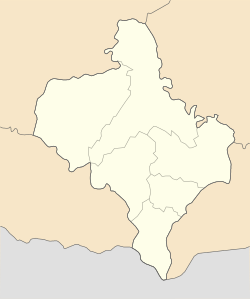Tysmenytsia
You can help expand this article with text translated from the corresponding article in Ukrainian. (March 2019) Click [show] for important translation instructions.
|
Tysmenytsia
Тисмениця Tyśmienica | |
|---|---|
 Church of the Nativity of Our Lady | |
| Coordinates: 48°54′03″N 24°50′57″E / 48.90083°N 24.84917°E | |
| Country | |
| Oblast | |
| Raion | Tysmenytsia Raion |
| First mentioned | 1143 |
| Magdeburg rights | 1449 |
| Population (2016) | |
| • Total | 9,357 |

Tysmenytsia (Template:Lang-uk Tysmenitsia; Template:Lang-pl) is a city, the administrative center of Tysmenytsia Raion in Ivano-Frankivsk Oblast of western Ukraine. Population: 9,357 (2016 est.)[1].
Geography
The city is also located in very close vicinity to the administrative center of Prykarpattia, Ivano-Frankivsk. It has a population of 9,600 people according to the Ukrainian Census (2001). The city is famous for its fur factory "Tysmenytsia" that was established back in 1891. In the Soviet times the factory was the fourth major factory within the fur industry of the Ukrainian SSR.
History

Tysmenytsia was first mentioned in documents from 1143, and in 1449, when the village belonged to the Kingdom of Poland, it received Magdeburg rights from Polish king Kazimierz Jagiellonczyk. At that time, it was a royal town, with a Polish name of Tysmienica. Due to its location near the restless southern border of Poland, Tysmienica was frequently raided and burned to the ground, by the Crimean Tatars and Wallachians.
A local Roman Catholic parish was founded by the Voivode of Braclaw Voivodeship, Mikolaj Potocki. The church was operated by the Dominican friars under prior Szymon Okolski, who opened a school here. At that time, Tysmienica belonged to the Potocki family, who invited Armenian merchants to the town. The Dominican monastery was destroyed in 1676, during the Polish–Ottoman War (1672–76), rebuilt in 1678, and expanded in 1763. In 1759, an Armenian church was opened in Tysmienica.
In 1686, King Jan III Sobieski visited the town, awaiting Polish soldiers, who returned from a raid on Moldova. Sobieski stayed in a house which was later named “Panski Dom”, and which was demolished in 1939. In 1772, Tysmienica was annexed by the Habsburg Empire, and remained in Austrian Galicia until late 1918 (see Partitions of Poland). The town, which burned in several fires, lost its importance to the nearby Stanislawow (now Ivano-Frankivsk), and lost its charter. In 1900, Tysmenytsia was in Tłumacz powiat.[2]
In the interbellum period, Tysmienica returned to Poland, and until the 1939 Invasion of Poland belonged to Stanislawow Voivodeship. In September 1939 it was captured by the Red Army, and Soviet authorities destroyed all ancient buildings, such as the Dominican church, Armenian church, the house of Sobieski, and historic cemetery. Under the German occupation, which began August 1941, the Germans, assisted by the Ukrainian police, murdered or deported to Stanislawow, all of the Jewish community of Tysmenytsia, which had numbered around 1500. Those sent to Stanislawow were later sent to the killing camp, Belzec. Few of Tysmenytsia's Jews survived the war.[3]
On March 28, 1982 Tysmenytsia became an administrative center of the former Ivano-Frankivsk Raion. Since then the name of raion was changed correspondingly to its administrative center – Tysmenytsia.
People
- Saint Job of Maniava, Ukrainian Orthodox saint born in Tysmenytsia
- Kost Levytsky, Ukrainian politician
- Henry Roth, Jewish American writer
- Oleh Lysheha, Ukrainian poet born in Tysmenytsia
- Jacob Kallmann Freud, father of Sigmund Freud
Sister Cities
Transport
Tysmenytsia can be reached by train, bus or by plane to Ivano-Frankivsk, which is about 20 minutes by bus from the city.
- Local orientation
- Regional orientation
References
- ^ "Чисельність наявного населення України (Actual population of Ukraine)" (PDF) (in Ukrainian). State Statistics Service of Ukraine. Retrieved 19 July 2016.
- ^ County of Tyśmienica Archived 2006-10-02 at the Wayback Machine (English version Archived 2006-08-15 at the Wayback Machine has less information)
- ^ Megargee, Geoffrey (2012). Encyclopedia of Camps and Ghettos. Bloomington, Indiana: University of Indiana Press. p. Volume II 845-6. ISBN 978-0-253-35599-7.
- ^ "Interactive City Directory". Sister Cities International.





